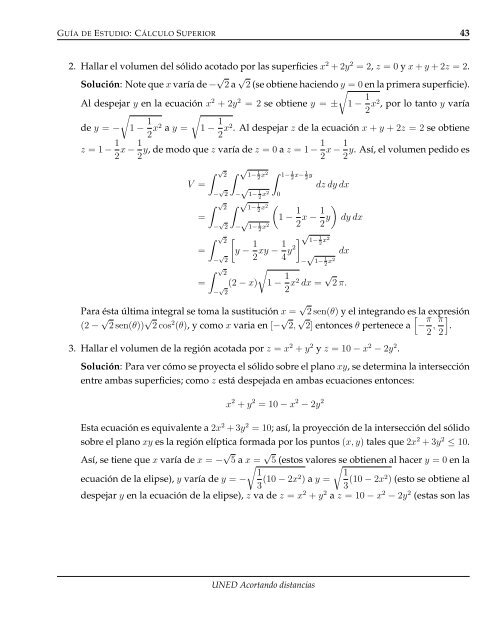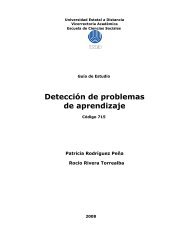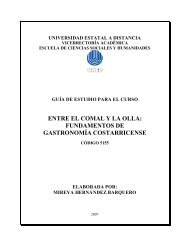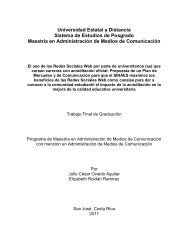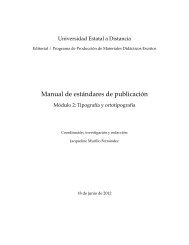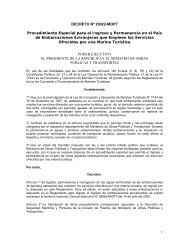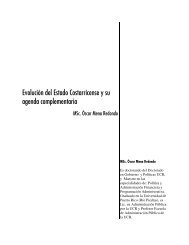GE3011 Cálculo Superior - Repositorio de la Universidad Estatal a ...
GE3011 Cálculo Superior - Repositorio de la Universidad Estatal a ...
GE3011 Cálculo Superior - Repositorio de la Universidad Estatal a ...
You also want an ePaper? Increase the reach of your titles
YUMPU automatically turns print PDFs into web optimized ePapers that Google loves.
GUÍA DE ESTUDIO: CÁLCULO SUPERIOR 43<br />
2. Hal<strong>la</strong>r el volumen <strong>de</strong>l sólido acotado por <strong>la</strong>s superficies x 2 + 2y 2 = 2, z = 0 y x + y + 2z = 2.<br />
Solución: Note que x varía <strong>de</strong> − √ 2 a √ 2 (se obtiene haciendo y = 0 en <strong>la</strong> primera superficie).<br />
Al <strong>de</strong>spejar y en <strong>la</strong> ecuación x2 + 2y2 <br />
= 2 se obtiene y = ± 1 − 1<br />
2 x2 , por lo tanto y varía<br />
<br />
<strong>de</strong> y = − 1 − 1<br />
2 x2 <br />
a y = 1 − 1<br />
2 x2 . Al <strong>de</strong>spejar z <strong>de</strong> <strong>la</strong> ecuación x + y + 2z = 2 se obtiene<br />
z = 1 − 1 1<br />
1 1<br />
x − y, <strong>de</strong> modo que z varía <strong>de</strong> z = 0 a z = 1 − x − y. Así, el volumen pedido es<br />
2 2 2 2<br />
V =<br />
=<br />
=<br />
=<br />
√ 2<br />
− √ 2<br />
√ 2<br />
− √ 2<br />
√ 2<br />
− √ 2<br />
√ 2<br />
− √ 2<br />
√ 1− 1<br />
2 x2<br />
− √ 1− 1<br />
2 x2<br />
√ 1− 1<br />
2 x2<br />
1 1<br />
1− x− 2 2 y<br />
0<br />
dz dy dx<br />
− √ 1− 1<br />
2 x2<br />
<br />
1 − 1 1<br />
x −<br />
2 2 y<br />
<br />
dy dx<br />
<br />
y − 1 1<br />
xy −<br />
2 4 y2<br />
√ 1− 1<br />
2 x2<br />
− √ 1− 1<br />
2 x2<br />
dx<br />
<br />
(2 − x) 1 − 1<br />
2 x2 dx = √ 2 π.<br />
Para ésta última integral se toma <strong>la</strong> sustitución x = √ 2 sen(θ) y el integrando es <strong>la</strong> expresión<br />
(2 − √ 2 sen(θ)) √ 2 cos2 (θ), y como x varia en [− √ 2, √ <br />
2] entonces θ pertenece a − π π<br />
<br />
, .<br />
2 2<br />
3. Hal<strong>la</strong>r el volumen <strong>de</strong> <strong>la</strong> región acotada por z = x 2 + y 2 y z = 10 − x 2 − 2y 2 .<br />
Solución: Para ver cómo se proyecta el sólido sobre el p<strong>la</strong>no xy, se <strong>de</strong>termina <strong>la</strong> intersección<br />
entre ambas superficies; como z está <strong>de</strong>spejada en ambas ecuaciones entonces:<br />
x 2 + y 2 = 10 − x 2 − 2y 2<br />
Esta ecuación es equivalente a 2x 2 + 3y 2 = 10; así, <strong>la</strong> proyección <strong>de</strong> <strong>la</strong> intersección <strong>de</strong>l sólido<br />
sobre el p<strong>la</strong>no xy es <strong>la</strong> región elíptica formada por los puntos (x, y) tales que 2x 2 + 3y 2 ≤ 10.<br />
Así, se tiene que x varía <strong>de</strong> x = − √ 5 a x = √ <br />
5 (estos valores se obtienen al hacer y = 0 en <strong>la</strong><br />
1<br />
ecuación <strong>de</strong> <strong>la</strong> elipse), y varía <strong>de</strong> y = −<br />
3 (10 − 2x2 <br />
1<br />
) a y =<br />
3 (10 − 2x2 ) (esto se obtiene al<br />
<strong>de</strong>spejar y en <strong>la</strong> ecuación <strong>de</strong> <strong>la</strong> elipse), z va <strong>de</strong> z = x2 + y2 a z = 10 − x2 − 2y2 (estas son <strong>la</strong>s<br />
UNED Acortando distancias


